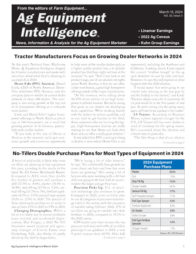Last month, I traveled to Lincoln, Neb., to cover the Agricultural Electronics Foundation Plugfest event. For hours on end, developers from around the world tested their platforms for compatibility in a round-robin format, hoping to fix any underlying issues en route to eventually achieving ISOBUS certification.
Among the many compatibility veterans in attendance was Dave Smart, staff systems engineer with John Deere and head of AEF’s high-speed ISOBUS development project. In working with AEF since 2001, Smart has contributed to the research and development of ag compatibility, helping develop universal standards to connect machines, implements and data for growers.
Speaking on behalf of his work with AEF and the industry wide goal of universal “plug-&-play” compatibility across all brands, Smart explains the current limitations of CAN-based ISOBUS in the field, and how the eventual implementation of an enhanced, high-speed ISOBUS network will provide unprecedented bandwidth for data collection and brand-to-brand functionality.
“The speed of CAN is very slow, and it's not unlike the dial-up modem from many years ago in the terms of performance. (It’s) no longer adequate in anybody’s home in these modern times, I would say. So the high-speed ISOBUS is intended to give us that next capability from an infrastructure perspective, and even though many of the operations would still be the same sort of thing, we still have the user experience, we still have prescription being applied, data logging and so forth. But now, instead of saying the planter's delivering 32,000 seeds per acre as the set point, (and) it’s) actually 31.5, we could instead have the bandwidth to get down to row level, and what is each row doing? And do I actually have a need to have a prescription that can adjust row-by-row-by-row?”
While acknowledging that the network is still under development, Smart adds that growers will have the ability for camera integration on implements for access to real-time viewing and data collection from the cab. Should it all come together as expected, perhaps we’re a lot closer to true “plug-&-play” than many would be led to believe.




Post a comment
Report Abusive Comment